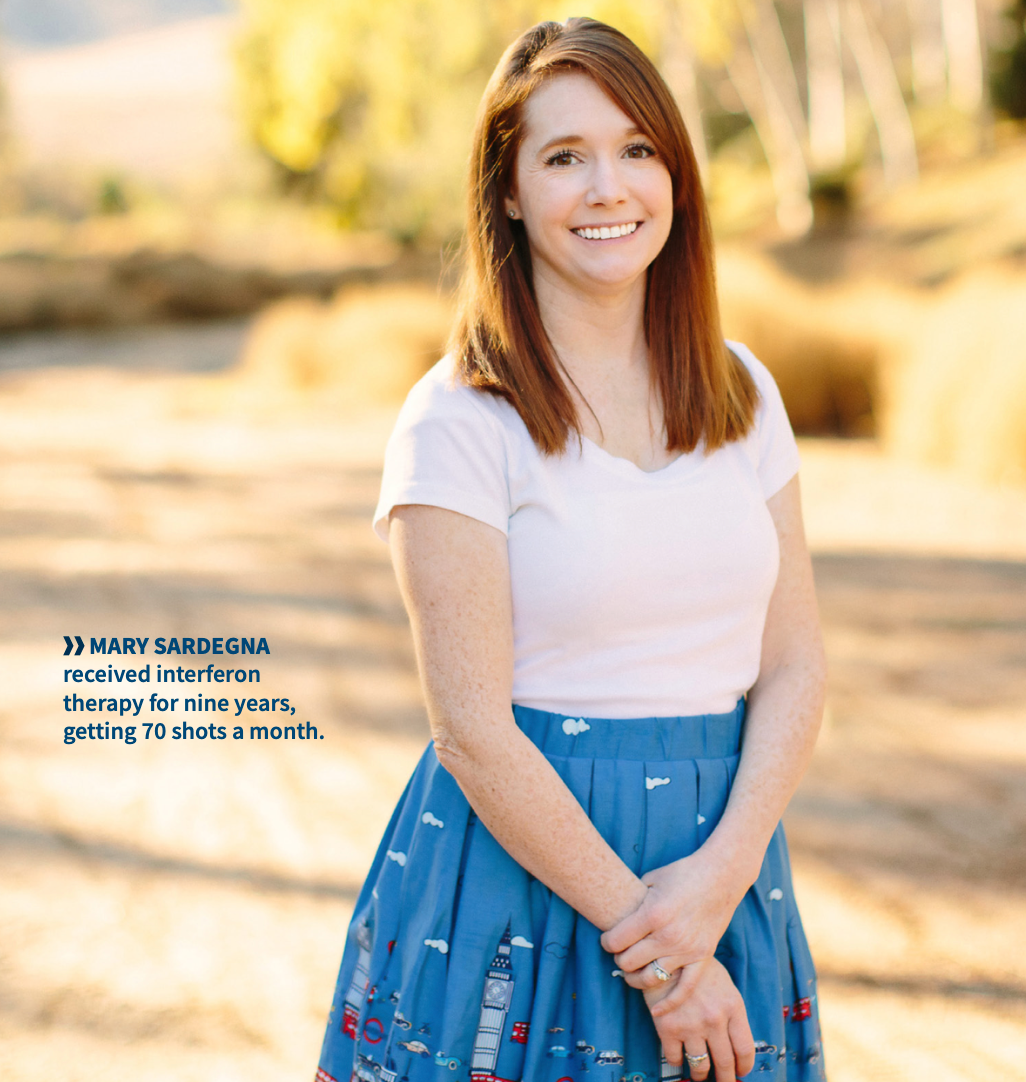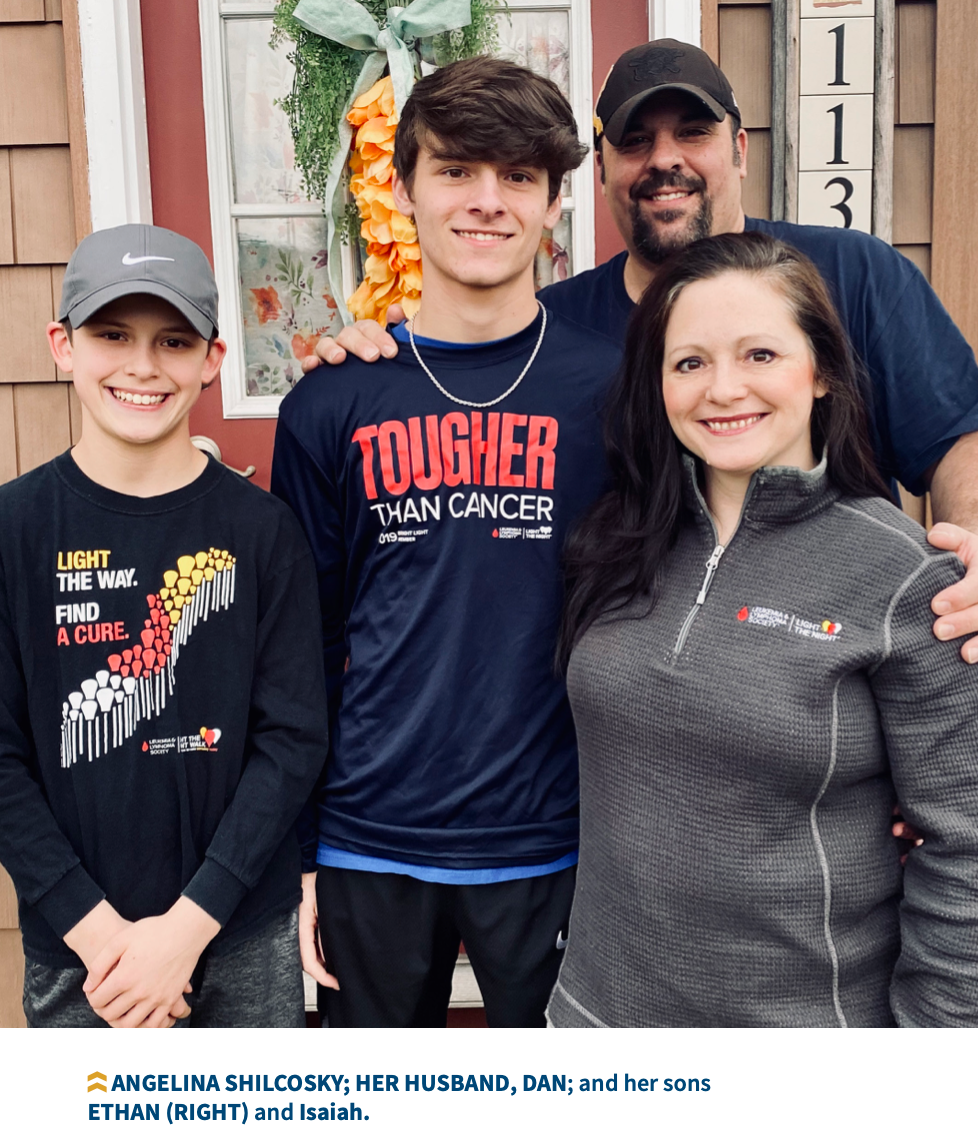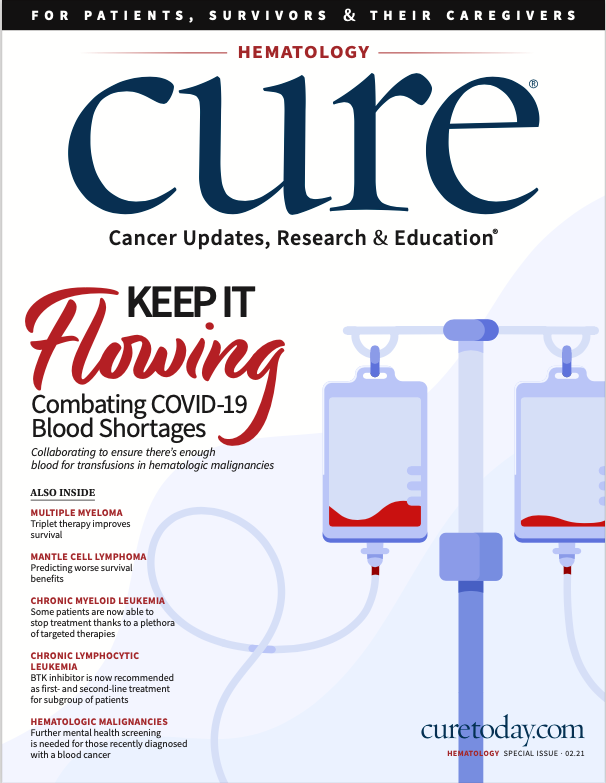Publication
Article
CURE
Knocking Out Chronic Myeloid Leukemia with Precision
Author(s):
Patients with chronic myeloid leukemia are living longer, some even stopping treatment, thanks to a plethora of targeted therapies.
Mary Sardegna was 2 years old when her parents noticed she wasn’t acting like herself. She was fatigued, had no appetite and often developed low-grade fevers. Then her stomach started to grow.
Several doctors thought she might have had the flu, and one suggested an enema to help with her bulging stomach. Eventually, a complete blood count (CBC) was performed, and it showed her white blood cell count was 525,000. A normal range is between 4,000 and 11,000 cells.

That’s when Sardegna’s parents were told that their daughter had chronic myeloid leukemia (CML), a type of blood cancer in which the bone marrow makes too many white blood cells. The bulge in her stomach was her white blood cells filling up her spleen.
“The only options in 1991 were bone marrow transplant, which had a 3% success rate, or a lifetime of medication,” recalls Sardegna, who lives in Laguna Hills, California. “My parents opted for the medication and were told by my doctor, ‘You’ll be sorry. There is no cure for this cancer. She’s going to die.’”
Sardegna was on interferon therapy for nine years, getting 70 shots a month. By 9 years old, she was injecting herself. “It was keeping the leukemia at bay, but it wasn’t helping it,” she says. “I was surviving, not thriving.” The medication made her tired, sometimes to the point where she would have to crawl across the floor to get to where she needed, and she developed a speech delay and learning disability.
“When I was in fourth grade, my mom got onto the internet — this was when it started to first come out — and she found a chat room where people were talking about a pill, STI-571. My pediatric oncologist had never heard of it,” Sardegna says.
STI-571 is now known as Gleevec (imatinib), a tyrosine kinase inhibitor (TKI) that targets BCR-ABL. This gene is formed on chromosome 22 when it fuses with chromosome 9; the abnormal chromosome is called the Philadelphia chromosome — a signature genetic aspect found in all patients with CML.
After researching the then-investigational drug, Sardegna’s mother found out about a clinical trial being conducted in Portland, Oregon, by Dr. Brian Druker in patients with CML. In 2001, they flew to Portland, and 11-year-old Sardegna became one of the few children allowed on the trial.
“Within nine months, I was considered cancer free,” she says. “I was less tired. I could walk and talk. I was thriving.”
Treatment advancements helped Sardegna, now 31, defy the odds. She was able to graduate college, get married and hold a job as a professional nanny. In January 2019, after 19 years on Gleevec, Sardegna safely came off treatment.
The Power of Five
Targeted therapies like Gleevec, the first Food and Drug Administration (FDA)-approved TKI for CML, have not only transformed treatment but also turned the once-deadly disease into a condition that can be managed.
In addition to Gleevec, a first-generation TKI, four others are approved by the FDA: Bosulif (bosutinib), Sprycel (dasatinib) and Tasigna (nilotinib), all second-generation TKIs; and most recently, Iclusig (ponatinib), a third-generation TKI.
“Before we had TKI or stem cell trans- plant, the average life expectancy was seven years,” says Dr. Jerald Radich, a medical oncologist at Fred Hutchinson Cancer Research Center in Seattle. “With (these) new agents, life expectancy is pretty much normal.”
Unlike acute leukemias, CML is slow growing, survival is longer and about 80% to 85% of cases are diagnosed incidentally
during routine bloodwork, according to Dr. Jorge Cortes, director of the Georgia Cancer Center at Augusta University in Augusta, Georgia.
Often, patients don’t know they have cancer lurking inside their body because symptoms aren’t obvious and they mimic other conditions. CML may cause fatigue, weakness, bone pain, fever and loss of appetite.
Joan Clements experienced all of the above. In 2000, she was caring for her husband who recently had had surgery and helped her mother move from Arizona to California, so she wasn’t focused on her own health. She just knew something wasn’t right. While carrying boxes in the moving process, Clements noticed bruising on her body. That’s when she made herself a doctor’s appointment and brought him a list of 14 signs of leukemia. However, when she received the results of her blood test, the nurse told her everything looked fine.

Clements got sicker, dropping 28 pounds in just under two weeks. She demanded a CT scan with full contrast. But before she could proceed with the procedure, she needed bloodwork. “When I got home that day, my phone was ringing and it was the doctor saying, ‘You have to come back to the hospital right now,’” says Clements, now 78, who lives in Costa Mesa, California. “My white blood cell count was 375,000.”
Clements, then 59 years old, learned she had CML and was told she had two to four years to live because there was no cure. Instead of waiting helplessly, she went to City of Hope Comprehensive Cancer Center in Duarte, California. That’s where she learned about Gleevec. “I said, ‘I want this drug. I’m going to fight this beast,’” she recalls.
Clements celebrated her 19-year “cancer-versary” in December. She’s thankful to still be alive because of Gleevec, which she will remain on for the rest of her life, but it didn’t come without unpleasant side effects, such as nausea, vomiting, fatigue, gastrointestinal issues, leg cramps, brain fog, full body rashes and periorbital edema, or swelling around the eyes. “It looked like water balloons on my eyes,” says Clements, who co-founded the CML Buster Foundation and leads its U.S.-based CML Busters family support group. Although many of these side effects are common when first taking TKIs, in Clement’s case, most subsided and the ones that remain — gastrointestinal issues, nausea and brain fog — are manageable.
Compared with chemotherapy, targeted therapy is more effective and typically has fewer side effects. “Chemotherapy is a bomb. You throw it and try to kill all the bad guys,” explains Cortes. “These targeted therapies are specifically directed to where the bad guys are to spare the good. It’s more precise.”
TKIs are given as initial treatment for patients, and the advantage to having so many is that if a patient doesn’t respond to one, the dose can be increased or they can switch TKIs. For those who can’t take TKIs, interferon or chemo- therapy may be used. And, although patients with chronic phase disease are rarely treated with stem cell transplants, that may be an option, especially for younger patients.
When deciding how to treat a patient, an oncologist takes into account many factors, such as comorbidities, schedule, cost, age and whether the patient is of childbearing age.
In three randomized studies, second-generation TKIs were compared with Gleevec, and there is no difference in overall survival, according to Radich. However, second- generation drugs achieve a deeper response more quickly, and they tend to have less disease progression to an advanced phase.
“If you have an older patient and aren’t worried about them going into advance phase or having kids, then you would go with imatinib,” says Radich. “If it’s chronic phase, but the patient has a big spleen and has been sick or is younger and they want a response so they can get off drug, they might be good for second-generation TKIs.”
Monitoring patients regularly in CML is common to see how well therapy is working. A polymerase chain reaction test is typically done every three months by blood or bone marrow, and it looks for molecular responses — seeing the number of leukemia cells. Hematologic responses can be measured through a CBC to make sure blood cell levels return to normal. To test for a cytogenic response, or examining mutated chromosomes, a doctor can use a bone marrow sample.
What’s in the Pipeline?
Although there is an abundance of treatment choices for patients with CML, researchers are always looking for something better.
“Several medications are in development to address specific resistance, a mutation called T315I, and the most significant development is a targeted drug that is similar to the available therapies, but it has a unique mechanism of inhibition,” says Dr. Michael Mauro, a hematologist at Memorial Sloan Kettering Cancer Center in New York City.
That drug is called asciminib (ABL001), and it targets the ABL myristoyl pocket. It’s known as a STAMP inhibitor. Results of a phase 3 clinical trial showed that the therapy was safe and improved response rates over current options. Experts anticipate it to be approved by the FDA this year.
“Sometimes the mutations don’t allow the TKI to find its place where it can do its job,” Cortes explains. “By binding in a different place, which asciminib does, it allows it to work and override the resistance.”
A medication being developed in China, HQP1351, is being examined for its efficacy. Its focus is zeroing in on the T3151 mutation, and it could potentially be a therapy for those with CML whose disease becomes resistant to a first- or second-generation TKI.
In a phase 1 study, the drug K0706 has shown to be safe in patients who have received at least three prior lines of TKI therapy. It’s effective against wild-type and mutated BCR-ABL1 proteins.
And in Russia, researchers are examining PF-114, which also has activity against the T3151 mutation, and has shown good responses.
Achieving Treatment-Free Remission
However, maybe most remarkable in the evolution of CML therapy is the emerging goal for patients to enter treatment-free remission, or TFR. It’s a decision that isn’t taken lightly.
In Sardegna’s case, when she asked her oncologist about it, she wasn’t met with open arms. Sardegna reached out to Druker, who has become a lifelong friend, for a second opinion, and he felt she was a great candidate.
To be considered for TFR, patients must reach a deep molecular response, which is defined as four to five reductions in disease burden, Radich explains. This needs to be sustained for at least two years.
Only about 40% to 45% of patients can stop treatment safely, according to Cortes, and about half will relapse.
Patients are monitored every month for the first six months with routine blood tests. Then follow-ups go down to every two to three months for the next two years, Mauro explains.

In September, Angelina Shilcosky was asked by her doctor whether she wanted to stop therapy because she had been in complete remission for a few years. “I was nervous at first, but it took stress off my mind,” says Shilcosky, 43, who received a CML diagnosis at 27 when she was three months pregnant and had a 2-year-old at home. “My mom and mother-in-law told me to stay on it. But I trust my oncologist, and he said if numbers (started) to change, we (would) go back on it.”
Shilcosky feels like she’s forgetting to do something each night because she popped a Gleevec pill daily for 14 years, but she feels thankful to be off it and gives back to the CML community by participating in the Leukemia & Lymphoma Society’s Light the Night campaign each year.
A downside to TFR is the potential for withdrawal symptoms, which Sardegna experienced. “Around six months after I stopped treatment, I got excruciating muscle pain,” she says. “It felt like my muscles were turning over.”
About 10% to 30% of patients who stop TKI therapy report withdrawal symptoms like bone pain and/or rash. However, most can be managed through over- the-counter medications, according to the Leukemia & Lymphoma Society.
“It’s important to remember that it’s a marathon, not a sprint,” Mauro says. “But it should be one where side effects are minimal and response is on target hitting milestones.”
For more news on cancer updates, research and education, don’t forget to subscribe to CURE®’s newsletters here.


























